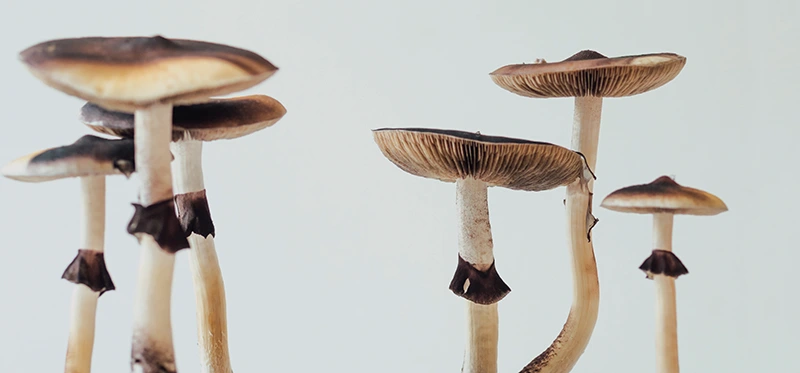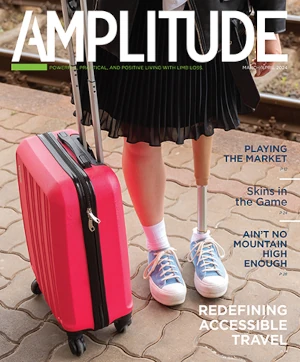By Rene Agredano

Every day for 40 years after he lost his left arm as a teenager, Warren quietly endured the constant hum of phantom limb pain (PLP) radiating from his residual limb.
“I just kind of took it for granted that there’s no way to get rid of phantom pain,” he says. “I never did anything but just live with it.” Aside from an occasional dose of Tylenol, Warren never sought any treatment for PLP. He never even mentioned it to his wife until they’d been married for 14 years. “She never knew the degree to which it was a permanent, systemic part of who I was,” explains Warren, now a 55-year-old tech industry analyst (he’s using an alias for professional reasons). “But my wife got obsessed with figuring out how to solve it.”
Her determination led Warren to try a cure he never dreamed would work—psilocybin, the active ingredient in hallucinogenic mushrooms. Despite his disinterest in drugs and his skepticism of health fads, Warren grew interested after his wife brought him a peer-reviewed study documenting how psilocybin and mirror therapy helped well-known scientist Albert Lin eliminate his phantom limb pain.
It took piles of additional research to convince a data-driven professional like Warren to try a substance that’s been banned in the United States since 1970. But after decades in the outlaw wilderness, psilocybin and other mind-altering drugs have begun to re-enter the medical mainstream. Researchers are amassing hard scientific evidence that, with proper clinical supervision, psychedelic drugs can help treat a host of hard-to-solve health challenges—including some that affect a high percentage of amputees.
Clinical trials are now underway to investigate psychedelics’ effects on PLP, intractable depression, post-traumatic stress disorder, and opioid addiction. The psychedelics-as-therapy movement is being led by preeminent medical research institutions such as Harvard, Johns Hopkins, and the University of California. It’s attracting significant seed money from pharmaceutical investors. It’s gaining acceptance at the ballot box: Several major cities and one state (Oregon) have voted to decriminalize certain hallucinogens. The trend has even spawned a national best-seller—Michael Pollan’s How to Change Your Mind—and a hit Netflix series of the same name.
Significant legal, scientific, and commercial barriers remain to be cleared before psychedelics make the leap from shady recreational drugs into safe, regulated medicines. It’s still illegal to possess psilocybin, ketamine, MDMA, LSD, and other psychedelics. Moreover, the medicinal value of those substances has yet to be scientifically proven. But at the rate things are going, it may not be long before doctors can prescribe a psychedelic fix for PLP, anxiety, depression, and other conditions related to limb loss.
What’s Old Is New
The current blossoming research into psychedelic medicine represents a renaissance of sorts. Research into the therapeutic potential of psilocybin, LSD, and similar compounds dates back to the 1940s. A peer-reviewed study of LSD’s effects on phantom limb pain appeared more than half a century ago in The Lancet, one of the world’s most highly respected medical journals. Parallel research found that psilocybin, mescaline, and other plant-based compounds could offer relief from deep depression, trauma, pain, and other mental disorders. These investigations yielded evidence that psychedelics affect the brain’s serotonin receptors and flood the body with feel-good hormones such as oxytocin and prolactin.

But just as these properties were being understood and scientifically documented, the U.S. government stopped everything. The Controlled Substances Act of 1970 banned a long list of hallucinogenic compounds that were seen as having a high risk for drug abuse and dependency. Prohibition was mainly a failure—too many hippies had described their far-out experiences with spindly mushrooms and postage-size stamps to quash the appetite for these magic meds. But the anti-drug laws relegated experimentation to informal, recreational settings and prevented it from occurring in clinical, scientific ones.
Today’s researchers have to overcome the stigma of criminalization, as well as the admittedly cringe-worthy nature of some early psychedelic research. “When LSD first made it into the clinic, lots of people didn’t know what to do with it,” says Dr. Frederick Barrett from the Johns Hopkins Center for Psychedelic and Consciousness Research. “There are horror stories of patients being strapped to a hospital bed and injected with LSD, and not told what to expect.”
Most of those old studies wouldn’t pass muster today. Instead, modern research utilizes high-tech neuroscientific tools such as MRI brain scans. They also happen in tightly controlled settings that place the patient’s emotional and physical comfort at the forefront. “Somewhere along the line, someone figured out that if you really turned this from a sterile hospital environment to something more supportive, and if you play people music, it can put some safety guardrails on the experience,” says Barrett. His team builds trust with volunteer subjects before administering the first dose, then conducts trials in comfortable, living room-style settings with gentle lighting and music. “People are directed to turn their attention inward, and that’s when—if you’ll forgive me—the magic happens.”
That magic made headlines in 2016 when Barrett’s team published a landmark study showing how psilocybin mushrooms can greatly relieve anxiety or depression in people with cancer. Last year the team received the first federal grant in 50 years to assess how psychedelic treatment might help people quit smoking. Similar research is taking place at major institutions such as the UC Berkeley Center for the Science of Psychedelics, the Psychedelic and Health Research Initiative (PHRI) at the University of San Diego, and the Center for Psychedelic Medicine at New York University. And private-sector startups such as Revive Therapeutics, Atai Life Sciences, and Cybin are raising millions of dollars for their own R&D, which they often conduct with academic partners.
Together, these investigators are piecing together a detailed picture of how psychedelics can alter perceptions of pain, trauma, and other difficult emotions. While much of their research has no bearing on limb loss, several areas of focus have the potential to improve amputees’ quality of life.
Remapping the Brain to Reduce Phantom Pain
“The brain is a prediction machine,” says Evan Lewis, head of neurology for Numinus, a Canadian startup focused on psychedelic therapeutics. “Disorders of phantom limb are disorders of the brain overpredicting the phenomena that is there. It’s a mismatch with what the brain is seeing, and the only way the brain can tell you that is through pain. What psychedelics do is smooth out and reduce your predictions. A window of opportunity opens up to help you begin to reprogram your predictions.”
That’s precisely how Albert Lin described his own experience with psilocybin. After suffering for nearly two years with debilitating PLP, Lin underwent guided mirror therapy while under the influence of a carefully prescribed dose of psilocybin. Over the course of several hours, he consciously retrained his brain to perceive an intact limb. “My mind had a map of my body, and it was experiencing severe feedback issues,” he later explained in a TED Talk. “But it had to let go of that map through a sort of ‘state of ego death’ in which the psilocybin allowed the mind to reject the old map and create a new one. Now I occasionally have a jolt of pain, but it’s mostly gone.”

Warren had a very similar experience when he sought relief for PLP at Eleusinia Psilo Retreat. Located near Mexico City, which has far more permissive regulations on psychedelic drugs than the US, Eleusinia caters to individuals with chronic pain conditions that don’t respond to traditional treatments.
“They come at this strictly from a science-based standpoint, and that felt comfortable to someone like me who’s very analytical,” Warren says. Upon arrival, he received an initial “mega-dose” of psilocybin mushrooms that helped him examine and process a lifetime of physical and emotional pain, parental loss, grief, and self-esteem challenges. During his second “micro-dose,” staff guided him through a mirror therapy session that changed everything for him. “At that moment, you have the mirror, and you have your hand. Then you touch the fingers together. And it was the first time in 40 years where I’d seen myself like that. I cried uncontrollably.”
Psilocybin-assisted therapy enabled Warren to process long-buried emotions wrapped up in his limb loss. Today he feels happier, more empathetic, and more self-aware. “You’ve had this brain your entire life, and now you’re exploring these areas that you didn’t even know were there—at 55! That is so exciting!” His phantom pain disappeared for two months after his treatment, but it returned during a time of heightened stress that interfered with his daily meditation practice. Warren understands that maintaining the results will require ongoing wellness habits. He receives post-retreat guidance from Eleusinia staff and participates in ongoing group therapy sessions. “It’s not an on/off switch,” he says. “It’s maybe a slow escalator ride down.”
Meanwhile, the University of California at San Diego’s PHRI is attempting to replicate Lin’s experience at a larger scale. The program will soon begin enrolling participants for the first randomized, placebo-controlled clinical trial to examine the safety and efficacy of psilocybin to treat PLP. Results aren’t expected for a couple of years, but the fact that such a study can even be funded represents significant progress.
Seeking Relief for Mental-health Ailments
“For those affected by mental health disorders, psychedelics have very acute, profound effects,” says Numinus’ Lewis. Plenty of people experiencing limb loss or limb difference fall into that category. Between one-third and one-half of amputees battle depression periodically, studies have shown. Many others suffer from anxiety, PTSD, and related conditions. Talk therapy, antidepressants, and other methods provide varying amounts of help, but many people cast about unsuccessfully for solutions. Psychedelics may offer an alternative.
Research into the mental-health potential of psychedelics blossomed after Barrett’s 2016 study at Johns Hopkins. That heavily cited project, a double-blind study involving 51 cancer patients with depression or anxiety, found that psychedelic-assisted therapy offered significant relief for major depressive disorder symptoms. A 2022 followup study reported that “substantial anti-depressant effects of psilocybin-assisted therapy, given with supportive psychotherapy, may last at least a year for some patients.”
Multiple studies are now underway involving a variety of psychedelic drugs. The PHRI has launched an investigation of psilocybin’s potential to help patients with chronic, intractable depression. A separate project is investigating the mental-health effects of the surgical anesthetic ketamine. This cheap, unpatented hallucinogenic compound has fewer governmental restrictions than other psychedelics, with positive effects similar to classical psychedelics. Last August, a ketamine clinic called MindPeace released data showing that 72 percent of patients experienced mood improvements after ten infusions, and 38 percent were entirely symptom-free. Some researchers believe ketamine may also have applications to treat chronic pain, OCD, PTSD, and autism.
For amputees who suffer from serious PTSD, the synthetic compound MDMA (more commonly known as Ecstasy or Molly) is being studied for its therapeutic potential. MDMA tends to decrease fearfulness, boost alertness, promote calm, and increase trust. The nonprofit Multidisciplinary Association for Psychedelic Studies (MAPS) recently earned FDA approval to conduct the second of two Phase 3 clinical trials of MDMA’s impact on patients with severe PTSD. An earlier trial showed incredibly promising results, with 88 percent of participants experiencing a reduction in symptoms and an astonishing 67 percent so greatly improved that they no longer met the criteria for a PTSD diagnosis.
The newly formed Center for Psychedelic Research and Therapy at the University of Texas is also laser-focused on treating PTSD with psychedelics. So is the University of San Francisco’s Neuroscape lab, which has launched investigations into MDMA-assisted therapy for people with moderate to severe PTSD.
Never Trip Alone
Despite all the research energy and media attention that psychedelics are getting, these solutions remain unavailable to most of the amputees who are inclined to try them. The drugs are still illegal in the United States, and the medical and scientific proof of their true health effects hasn’t been established. Even the most promising experimental therapies have yet to earn FDA approval.

An offshore psychedelics tourism industry has sprung up to serve Americans who want to try psychedelic cures but aren’t able to in the US. Guided psychedelic retreats such as Eleunisia, where Warren experienced his psilocybin epiphany, are springing up in Mexico, Costa Rica, Jamaica, and other Western Hemisphere locales. Most of these venues specialize in a specific psychedelic substance, with psilocybin mushrooms and the South American ayahuasca brew most commonly offered. While these locations can tout many success stories like Warren’s, they are largely unregulated and their results are unverified. There’s little to no recourse for participants who fail to get the outcomes they are seeking. If you choose to try one of these retreats, you attend at your own risk.
The same principle applies even more strongly to anyone who obtains psychedelics illegally in the US and self-medicates at home.
“Some of these drugs are very powerful, and they have compounds that could have pretty severe interactions with other drugs,” cautions renowned ethnobotanist Cassandra Quave, a congenital amputee and author of The Plant Hunter: A Scientist’s Quest for Nature’s Next Medicines. “Interactions with common drugs that amputees may take, such as anti-depressants, anti-psychotics, pain medications, and anxiolytics, can be especially problematic. If you take [psilocybin] with cough medicine, it could make you very, very ill. You should always speak with your doctor before trying psychedelics.”
“Anyone considering doing psychedelics on their own to resolve a condition may be headed for failure,” adds Lewis. “It’s really important to understand that the true benefit of psychedelics experience comes when it’s bootstrapped through the appropriate therapy.”
Those therapies can’t arrive soon enough for many people with limb loss. And for those who’ve grown jaded watching one pioneering idea after another fall short of expectations, Warren has a simple message. “My takeaway for people is to be open and look at it,” he says. “I have so many good things to say about them. You can elevate your life in so many ways.”




